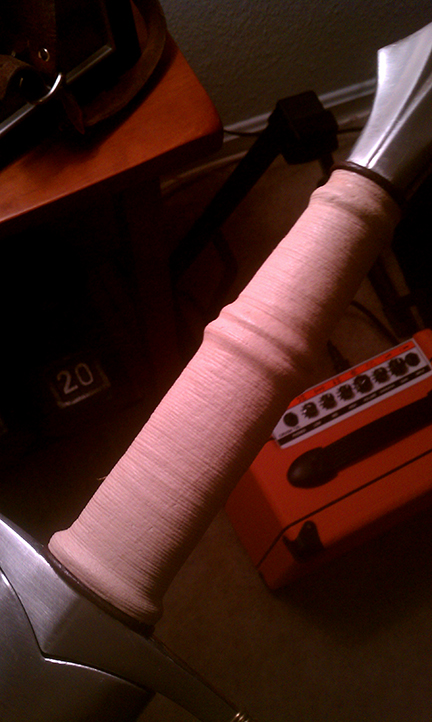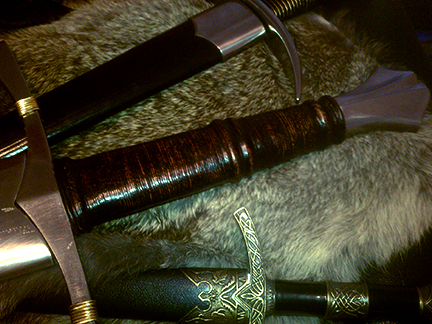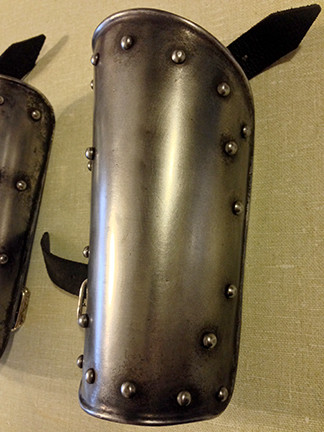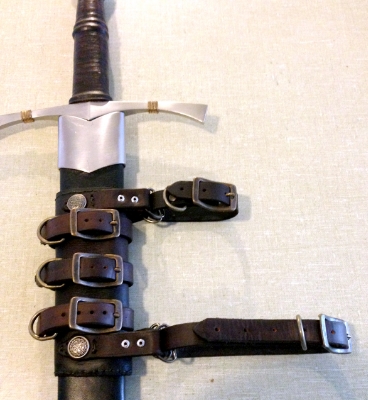| Author |
Message |
|
Christopher Franklin
|
 Posted: Mon 25 Nov, 2013 10:07 am Post subject: Training Swords and Modifications Posted: Mon 25 Nov, 2013 10:07 am Post subject: Training Swords and Modifications |
 |
|
Hello!
I'm currently researching steel blunt swords for training, and after having read the countless wonderful reviews at this site, I still have a few questions that I'd be greatly appreciative of any insight anyone might have to offer.
SIZE
Which is more important: a longer blade length that compensates for a shorter reach, or a shorter length that makes sheathing/unsheathing easier? I ask because when unsheathing an Italian longsword with a 35.5" blade, my shoulder always pops at the last inch or so (I'm 5'6").
TYPE
I'm a guitarist, so the adrenaline pumping desire of wanting every piece of gear you see is not new to me, but in this instance it's compounded with my ignorance...I've limited my choices down to a few pieces from Ablion and Arms & Armor:
Ablion
The Liechtenauer
Arms & Armor
The Fechterspiel
The Spada da Zogho
Granted, everyone is different and the choice of a sword comes down to personal choice and intention of use, so it's impossible to expect a worthwhile "THIS one will be PERFECT for YOU" answer, but I'd love to hear anyone's thoughts on these swords outside of any singular review.
Do you find that having the schilt is a requirement for training, or are its benefits negligible in comparison to a better built, schilt-less sword? I'll fully admit that I'm hesitant to grab a sword with a schilt (right now, anyway) due solely to aesthetics - I can only afford one new sword right now, so having one that I can train with, and also use for upcoming cosplay photography/display sessions without the sword obviously being a trainer is something I'm considering. That being said, safety and quality of training is FAR more important, so it's good to know how the existence of a schilt on a sword affects those attributes.
MODIFICATIONS
I don't think I'm a fan of the bare hemp chord on the Ablion swords, and find the Arms and Armor hilts to be uninspired (I'm a graphic artist, so these things matter to me, ha). Are these swords made such that one can rewrap them and add/remove risers without sacrificing anything and/or do training schools frown on modifying your training sword hilts?
I do have experience with rewrapping hilts and repositioning risers, after doing so on my italian long sword:


Thanks for any advice and input. It's greatly appreciated! Oh, and so this post is more than just "help me!", here's a couple other things I've done that hopefully you'll enjoy 
This was a brand new, shiny bracer, until I aged it.

This is a sword frog I made.

|
|
   |
 |
Michael B.
Industry Professional

Location: Seattle, WA Joined: 18 Oct 2007
Posts: 367
|
 Posted: Mon 25 Nov, 2013 11:20 am Post subject: Posted: Mon 25 Nov, 2013 11:20 am Post subject: |
 |
|
Welcome to the community!
I personally fight and train with the Spada da Zogho from Arms & Armor, I love it, almost everyone that I train with has different swords though. However, if I was you, and you really wanted to have one that you could use for cosplay photography/display sessions I would got for the Albion Liechtenauer and rewrap it if you want. The Albion will look more "real" for cosplay and photos but still be good and safe for training. The arms and armor selections have a much more utilitarian look to them.
www.facebook.com/bearmountainforge2
Michael Bergstrom
|
|
   |
 |
|
T. Kew
Location: London, UK Joined: 21 Apr 2012
Posts: 256
|
 Posted: Mon 25 Nov, 2013 12:06 pm Post subject: Posted: Mon 25 Nov, 2013 12:06 pm Post subject: |
 |
|
A few thoughts and comments:
No blunt sword is really going to look sharp. A properly made sparring blunt with good weight distribution will have a narrower blade with a strange taper, at least when compared to a sharp with approximately the same handling properties. You could consider getting a sword with a schilt and explicitly doing costumes as a person with training/sparring equipment, at least to start with? Make it clear in displays that "the equipment we are using here is designed to represent historical training equipment".
From a safety perspective, my understanding is the schilt will generally make the bind a little safer, by keeping it somewhat further from your hands. It does seem to be basically standard on the feders used by most of the HEMA community that I've seen, make of that what you will. On this subject, it might also be worth looking at some of the European training sword makers. Good things get said about Regenyei feders, and they seem to be common in several competitions.
Much more important than a long blade to try and make up for your reach disadvantage is a blade properly sized for you. Keith Farrell has some quite nice commentary on Martial Arts for shorter fighters, including some discussion specifically of the "shorter fighter should use a longer weapon" thing. Having said this, 36" or so of blade is quite common on longswords, as is a weapon which reaches in overall length from the floor to your armpit or so. If you can't draw one of that size, it might be worth looking at how you're suspending the scabbard first - it could be possible that a different suspension gives you that extra inch without throwing your shoulder out.
Rewrapping a hilt is a personal taste matter, really (assuming you don't go removing it or whatever). But remember that for a training weapon, the hilt will probably take a battering over time, as you take hits to it and so on. This probably isn't the place for an exceptionally carefully worked piece with multicoloured dye patterns and tooling.
All that said, good luck with your choice and future training. You're looking at some quite high quality swords, and I doubt that any of them will be a poor choice.
HEMA fencer and coach, New Cross Historical Fencing
|
|
  |
 |
|
Ben Coomer
|
 Posted: Mon 25 Nov, 2013 7:48 pm Post subject: Posted: Mon 25 Nov, 2013 7:48 pm Post subject: |
 |
|
Well, I haven't gotten them yet, but my wife and I are going to be getting a pair of zogho from A&A soon. Mainly as we want something a bit more customized. She wanted something a bit shorter and I really prefer wheel pommels. The a&a rep has been very helpful in figuring out everything, particularly in keeping them close to the original prices. Relatively sure that getting the hilt the way you want it wouldn't be too hard for them, if you're willing to pay for it.
That being said, our real swords are from Albion and I do like their practice swords I got to handle, but they don't do customizations and we prefer our training tools to resemble as close as possible to our reals, so we are going with a&a. Its more asthetics than anything wrong with the Albion line.
|
|
  |
 |
|
Matthew P. Adams
|
 Posted: Mon 25 Nov, 2013 7:54 pm Post subject: Posted: Mon 25 Nov, 2013 7:54 pm Post subject: |
 |
|
Have you looked at the squire line 15th century bastard sword? They are sold blunt, and can be used for controlled sparring if you add a fencing tip to the point. It doesn't have the hemp wrapping, and it would look like a sharp for a costume piece. Plus with a 33" blade length it's a good size for you.
http://www.albion-swords.com/swords/albion/sq...astard.htm
"We do not rise to the level of our expectations. We fall to the level of our training" Archilochus, Greek Soldier, Poet, c. 650 BC
|
|
  |
 |
|
Christopher Franklin
|
 Posted: Sun 01 Dec, 2013 2:16 pm Post subject: Posted: Sun 01 Dec, 2013 2:16 pm Post subject: |
 |
|
Sorry I haven't replied sooner - thanksgiving holidays and all that. I appreciate everyone's advice!
I've looked at similar bastard swords, but am unsure if a) simply being a blunted weapon is acceptable for training and b) if that or similarly sized swords are usable in the area of German fencing I'm studying. I suppose I'll have to chat with my coach, but as it stands, I think I'm leaning towards the Albion Liechtenauer (for now, anyway).
|
|
   |
 |
|
T. Kew
Location: London, UK Joined: 21 Apr 2012
Posts: 256
|
 Posted: Sun 01 Dec, 2013 2:40 pm Post subject: Posted: Sun 01 Dec, 2013 2:40 pm Post subject: |
 |
|
The key advantage of a proper training weapon is that it's got flex for the thrust, while many blunts are significantly more rigid, which is not exactly a good thing if you intend to stab people with it with some force behind it. Most feders will actually have the flex focused near the end of the blade, so that there is still a fair bit of strength available to bind with, but thrusts are not too painful or damaging.
Additionally, the edge geometry of a blunted weapon can still be quite acute and risky to deliver hard blows with, which is also unpleasant for your training partner.
Your first adviser for queries should definitely be your teacher, as fundamentally it's their call on what's acceptable in their classes. I would still go for a feder by Regenyei or the like as a first choice, myself, but others are valid.
HEMA fencer and coach, New Cross Historical Fencing
|
|
  |
 |
Jimi Edmonds

|
 Posted: Wed 04 Dec, 2013 10:29 pm Post subject: Posted: Wed 04 Dec, 2013 10:29 pm Post subject: |
 |
|
I have both the Albion Liechtenauer and Arms and Armour Fechterspiel.
The Albion I was drawn to by the looks, and the reviews. The cord wrap, well mine anyway is a darkish brown from blood and sweat...mostly sweat ahah and is not rough on the hands, though after near four years of use that would do it.
I love the sword, it has held up well. Some say its a hard hitter and yes that is correct, though in unarmoured fighting theres no need to hit hard, as not much force is needed to cut or stab someone.
I like this sword for earlier longsword art.
Should it ever fail I have vowed to aquire another.
The Fechterspiel, well it just hasn't grown on me as the Liechtenauer has, and I sort of wished I had brought another Albion, but that being said it is longer and is actually quite nice to fence with, it is lighter and you can go faster, not that I don't with the latter. The grip is a tad fat, but this I will later change when the leather has run its course, the shilt has its moments and can save fingers. I brought it so I could have two varients of swords and it would fit for later German longsword art. I am going to try and use it more this summer.
Personally for me its a look thing, but if you were to add a more sword like blade to the hilt it would look pretty mean.
Pros on the Liechtenauer, I love everything about it. Nice the fence with, Looks like a 'real' sword. Peened.
Cons being aware that it can hit hard, but thats about all.
Pros for the Fechterspiel, a long blade, nice to fence with, can add speed, replacable blade, handy verses rapiers!
Cons needs constant oiling, rusts fast, not peened, fat grip..
Others that I know prefer the fechter over the liecht and visaversia.
Though for me its like Playstation or Xbox, both are great but I favour one over the other..
|
|
  |
 |
|
Raman A
Location: United States Joined: 25 Aug 2011
Posts: 148
|
 Posted: Thu 05 Dec, 2013 10:06 am Post subject: Re: Training Swords and Modifications Posted: Thu 05 Dec, 2013 10:06 am Post subject: Re: Training Swords and Modifications |
 |
|
| Christopher Franklin wrote: |
SIZE
Which is more important: a longer blade length that compensates for a shorter reach, or a shorter length that makes sheathing/unsheathing easier? I ask because when unsheathing an Italian longsword with a 35.5" blade, my shoulder always pops at the last inch or so (I'm 5'6"). |
Do not try to compensate a short reach with a longer weapon. Any modern martial artist will tell you this is a bad idea. The historical manuals clearly state this as well.

To know the perfect length of your sword, you shall stand with your sword and dagger drawn, as you see this picture, keeping out straight your dagger arm, drawing back your sword as far as conveniently you can, not opening the elbow joint of your sword arm, and look what you can draw within your dagger, that is the just length of your sword, to be made according to your own stature... The perfect length of your two handed sword is, the blade to be the length of the blade of your single sword.
from George Silver's Paradoxes of Defence 1599:
http://www.pbm.com/~lindahl/paradoxes.html
Section 30, "Questions and answers between the scholar and the master, of the vantages and disadvantages between a tall man, and a man of mean stature, having both the perfect knowledge in their weapons" may be of interest to you as well though it's unrelated to your questions.
If you do the experiment that Silver instructs and find your weapon is not too long, your problem with unsheathing may have to do with your suspension or drawing technique.
|
|
  |
 |
|
|
You cannot post new topics in this forum
You cannot reply to topics in this forum
You cannot edit your posts in this forum
You cannot delete your posts in this forum
You cannot vote in polls in this forum
You cannot attach files in this forum
You can download files in this forum
|
All contents © Copyright 2003-2024 myArmoury.com — All rights reserved
Discussion forums powered by phpBB © The phpBB Group
Switch to the Basic Low-bandwidth Version of the forum
|

